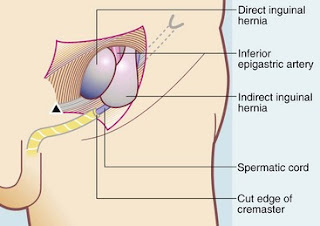4.2 An indirect inguinal hernia with
its sac leaves the abdominal
cavity at the internal ring and passes
medial to the stuctures of
the
permatic cord either
remaining in the
inguinal canal
(bubobnocele) or
descends all the way into
the scrotum. The
indirect hernia lies within the fibres
of the cremaster muscle.
4.3
A direct hernia (Fig. 24.10)
emerges through the posterior
wall of the inguinal canal formed by
the transversalis fascia, in
the
Hasselbach's triangle, bounded
laterally by the
inferior
epigastric artery
and medially by the lateral margin
of the
rectus sheath.
For a direct hernia to develop, either
transversalis fascia must
be weak or torn by physical effort.
A
direct hernia projects through the canal's posterior wall, it
does
not lie within the cremaster muscle fibres. This
type of
hernia is
unlikely to reach
the scrotum. The
clinical
differences
4.4 The third groin hernia; the
femoral type also depends upon a
defect in the transversalis fascia in
Hesselbach's triangle.
In
this type of hernia, the peritoneal sac passes
under the
inguinal ligament into the femoral
triangle rather than following
the
course of the direct hernia
anteriorly into the
inguinal
canal.
The
femoral canal is medial to the femoral vein and the femoral
hernia projects into the canal.
The
sac has a
very narrow neck,
because of this
fact,
strangulation occurs more frequently
in this hernia.
Large
femoral hernias cross over into the inguinal region
from
the femoral triangle in front of the
inguinal ligament.
Any questions be sent to drmmkapur@gmail.com
All older posts are stored in archives for access and review.
Visitors that follow may post contributions to the site,please write to address above.
To create consumer/provider engagement visit www.otmanage.blogspot.com
www.sutgistruatlas.blogspot.com www.drmmkapur.blogspot.com



No comments:
Post a Comment